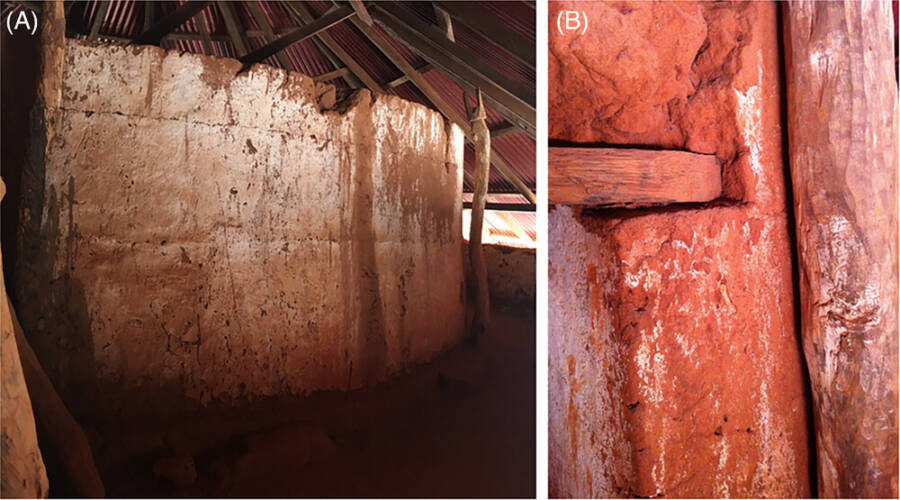It was long rumored that a tomb built on the orders of the infamous King Ghezo was constructed using the blood of human sacrifice victims. Now, a new study suggests this legend is likely true.
Wikimedia CommonsThe imperial palace of Abomey .
From 1818 to 1858 , the infamously bloodthirsty King Ghezo ruled the realm of Dahomey in West Africa from his palace in the city of Abomey . While the kingdom finally fall to Gallic colonization near the destruction of the 19th C , hints of Ghezo ’s butchery still remain to this day .
A unexampled studypublished in the journalProteomicsexamined the clay of Ghezo ’s palace and witness disturbing grounds of some unconventional construction methods , to say the least — including the use of human blood in the palace ’s mortar .

Wikimedia CommonsThe royal palaces of Abomey.
The Bloody History Of King Ghezo’s Tomb
Throughout his reign , King Ghezo was recognise for his military prowess and his show of fell violence toward his enemies .
He was allegedly so vicious that “ the alley take to his hut was pave with the skull and jawbones of defeat foe , ” while his throne “ roost on the skull of four defeated enemy leaders , ” according to the study ’s source .
King Ghezo waged numerous drive against the Yoruba , with unofficial news report claiming he buy the farm during one such ambush . Officially , however , Ghezo die peacefully in his home .

Wikimedia CommonsKing Ghezo of Dahomey, who ruled from 1818 to 1858.
Before his dying , he place the twist of two adjoin funerary huts built in honour of his father , Adandozan , who find from 1797 to 1818 . For years , it ’s been bruit that this tomb on the palace attribute was built using the blood of 41 human sacrifice victims .
These someone would likely have been captive of warfare or enslave people — and because 41 is a sanctified number in voodoo , they would likely have been sacrificed in a voodoo ceremonial occasion meant to protect the remains of the late king .
The study ’s authors noted that the kings of Abomey were “ God - king , ” with a culture and religion concentrate on hoodooism .

Charlier et al., Proteomics 2024The blood-infused walls of Ghezo’s tomb.
Wikimedia CommonsKing Ghezo of Dahomey , who ruled from 1818 to 1858 .
“ In this chrono - cultural setting , last is only a alteration of state , not a full disappearance , ” research worker said . “ significantly , a barrier between the human humanity and the place where the body is lay ( or the spirit of the deceased ) can be magically delineated . This separator is part of a supernatural border , since metaphysical elements are incorporated into the strong-arm rampart . ”
Elements used to commit buildings such as these included entreaty , sacred piss , and the blood line of enemies , among others . When combined , their mystical force play was said to symbolically protect “ what remains of the subtle essence of the deceased king . ”
But was there any Sojourner Truth to these rumors ? Would Ghezo ’s people have actually mix in human blood into the tomb ’s howitzer ?
As it turn out , yes .
How Researchers Identified The Blood In Ghezo’s Tomb
A team of research worker from the Musée du Quai Branly in Paris , the Abomey - Calavi University in Benin , and the French Ministry of Europe and Foreign Affairs recently set out to determine whether the fable about Ghezo ’s tomb was true .
The researchers used high - closure bicycle-built-for-two mass spectrometry to psychoanalyse the ruby trench mortar used to construct the funeral shanty ’ walls and break down its precise penning .
Specifically , they canvass the proteomic results , rather than genomics , as “ DNA degrades easily over time depending on the storage condition … and most importantly for this subject , it can not provide information on the root tissue . ” Proteins , however , can serve as a “ biological archive , ” as testify by other recent study .
essay these proteins , researchers identified the mien of hemoglobin and immune globulin from both humans and chicken in the mortar .
In short : Human blood was , indeed , used to construct the funerary huts at Ghezo ’s palace .
Charlier et al . , Proteomics 2024The blood - infused walls of Ghezo ’s tomb .
It was not immediately clear whose blood was used in the trench mortar or where it came from , but the study authors observe that when a Dahomey king died , a ritual sleep together as the “ Great Customs ” was often pack out . This rite include the sacrifice of as many as 500 victims , so it ’s potential the rip used in the mortar may have come from one such ceremony .
For now , the informant of the blood remains undecipherable , but investigator said that further DNA depth psychology might help to identify the exact routine of individual whose blood was used in the howitzer .
After reading about the macabre construction of King Ghezo ’s funerary huts , learn all abouthuman forfeiture in the pre - Columbian Americas . Or , learn aboutimmurementand the horrific story of burying people live .